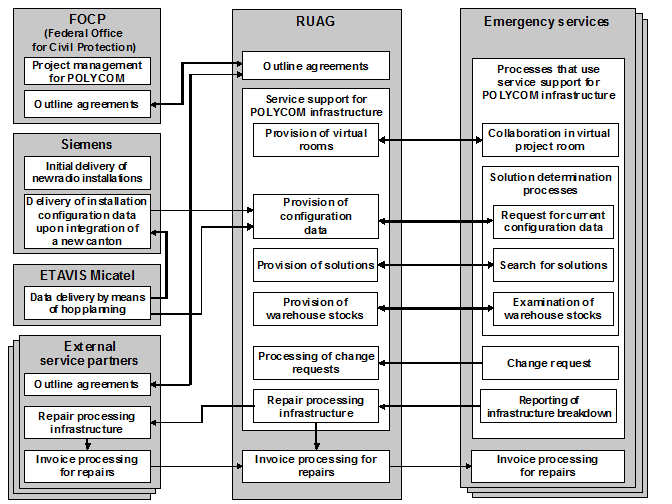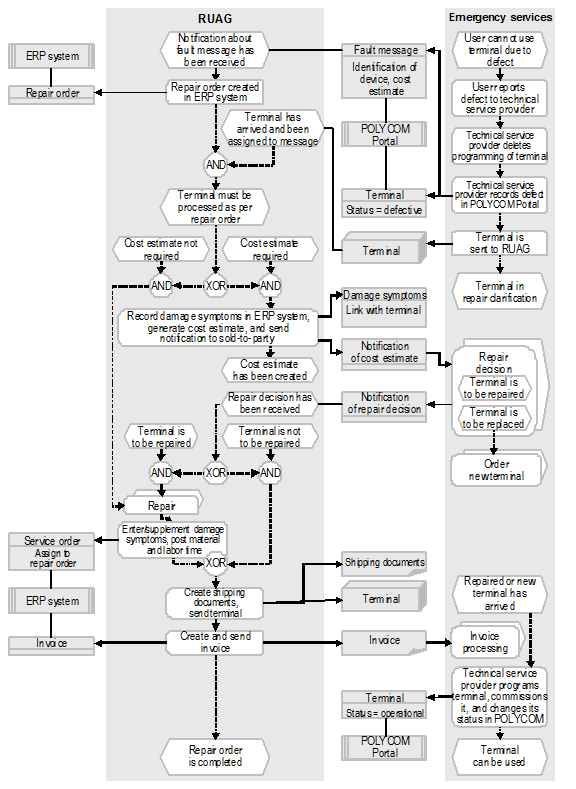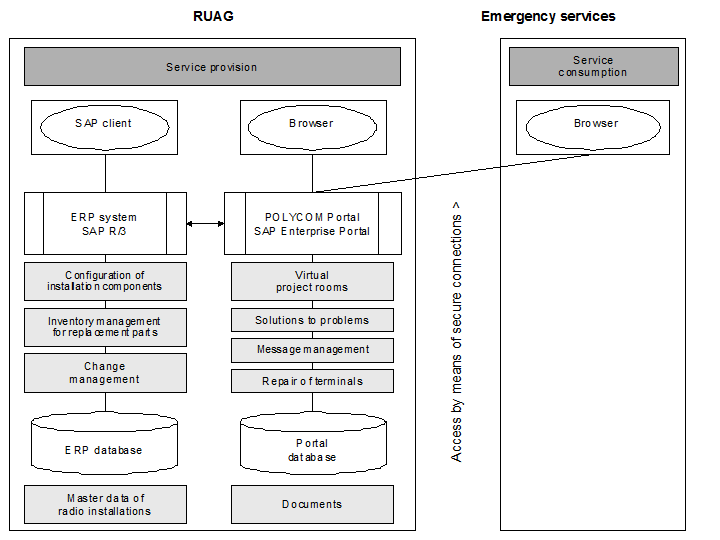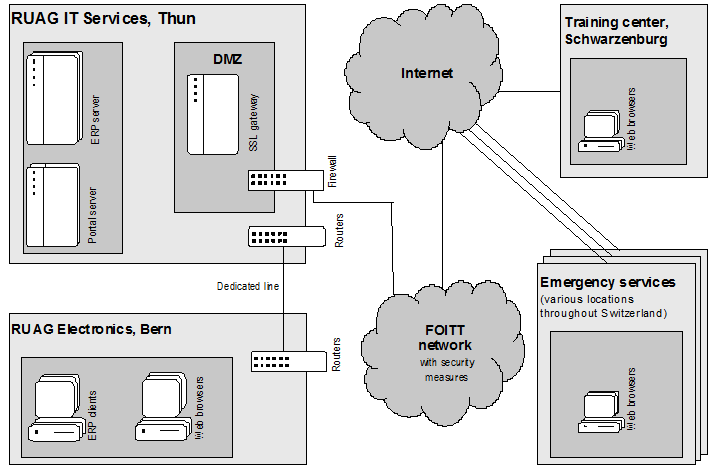POLYCOM Portal: Service Support for the Swiss Security Radio Network
The Swiss security radio network, POLYCOM, is the radio system of the emergency services in Switzerland and is used, for example, by the border police and fire department. The subnetworks are maintained by the cantons. To ensure service support for POLYCOM, RUAG Electronics maintains an information platform called the POLYCOM Portal, which is based on SAP R/3 and SAP Enterprise Portal. The portal makes the specification and status of the individual components transparent to the numerous parties involved and is, therefore, a key factor in ensuring functional security and efficient maintenance. The POLYCOM Portal gives authorized users personalized access and supports the triggering of processes such as the repair of terminals.
Inhaltsverzeichnis
1. POLYCOM2. What Triggered the Project
3. POLYCOM Portal: Service Support for the Security Radio Network
Business Perspective, Process Perspective , Service, Application Perspective , Information Management, Technical Perspective , Application Service Providing
4. Project Flow and Operation
Project Management, Roll-Out
5. Experiences
Investments
6. Success Factors
E-Collaboration
1. POLYCOM
A national radio system for the Swiss emergency services is set up and operated under the name POLYCOM. Since this involves several partners, this case study focuses on the POLYCOM project rather than on a single company. To this end, the following sections first describe POLYCOM and then the POLYCOM Portal.
POLYCOM facilitates radio contact both within and between the various emergency services such as the border police, police, fire department, paramedics, and civil defense organization as well as the supporting groups within the army. The aim of the POLYCOM project is to allow all national, cantonal, and local emergency services to transmit radio conversations and data using a standard, homogenous infrastructure. The Swiss Federal Office for Civil Protection (Federal Department of Defense, Civil Protection and Sport) is responsible for managing the POLYCOM project and coordinates the national setup and operation of POLYCOM. The POLYCOM project comprises setup and operation as well as the network itself.
The foundation was laid by a ruling of the Swiss Federal Council on February 21, 2001, which states that the Swiss state, cantons, local authorities, and organizations involved are to share the costs incurred. Due to this federal financing model, it will take several years to set up POLYCOM nationwide. The speed of implementation is also determined to a great extent by the political decisions of the cantons. The aim is to have the POLYCOM radio network set up nationwide by 2012. Numerous other partners besides the FOCP are involved in setting up and maintaining the POLYCOM project, such as RUAG Electronics, Siemens Schweiz, ETAVIS Micatel, and so on.
Background, Industry, Product, and Target Group
The Swiss emergency services started to communicate by radio in around 1940. Different radio networks were set up to suit various requirements without much coordination effort. The PPT (Post, Telefon und Telegraph) was responsible for assigning frequencies at the time. Several attempts to establish a common radio standard failed due to insufficient acceptance by the individual radio network operators. A further attempt was made in 1996, which can be seen as the starting point of the current POLYCOM project. The aforementioned ruling of the Swiss Federal Council formed the basis for the decision to create a standard radio network and laid the foundation for POLYCOM. A detailed design for setting up and operating POLYCOM was then developed. The shortcomings of the incompatible radio networks will be reduced over the next few years by implementing POLYCOM. This digital trunk radio network is suitable for both voice and data traffic. It is possible, for example, for the fire department to form an ad-hoc user group with different intervention elements from the police, paramedics, or civil protection organization. The target group is all national, cantonal, and local emergency services.
The POLYCOM Vision
The aim is to have a communication network for all emergency services in operation by 2012 that is comprehensive, standardized, standalone, and crisis-proof.
2. What Triggered the Project
The following sections focus on the POLYCOM Portal subproject. The POLYCOM Portal provides service support for the Swiss security radio network. It is the central platform for all the information (data) that is exchanged between the partners involved within the scope of maintaining and adjusting the infrastructure.
Initial Situation and Trigger for the Project
The POLYCOM Portal project was triggered by the cantons, which carry out some of the maintenance work for their radio network themselves. To do this, they require the current configuration data of the individual installation components. Since this data is stored centrally at RUAG, which is responsible for service, it was a logical service enhancement to make this data available to a wider user group. In addition, the FOCP regularly publishes documents for a specific user group and a portal solution enabled it to eliminate the problems associated with physically sending the documents and with version management.
Our Business Partners
Within its scope of responsibility, the FOCP ensures that the Swiss Federal Council's ruling of 2001 is implemented. RUAG Electronics is responsible for configuration management, RUAG IT Services for maintenance, and itelligence AG for developing the POLYCOM Portal.
RUAG Holding: RUAG Electronics and RUAG IT Services
RUAG is an international technology group with headquarters in Bern. Its technologies meet the strict requirements for precision in production and maintenance in the areas of aerospace and defense as well as in the automotive, electronics, and engineering industries. RUAG has around 5,700 employees worldwide.
itelligence AG
itelligence AG is an end-to-end SAP service provider that employs around 1,100 staff worldwide at 33 branches in 15 countries. As a certified SAP partner in several categories, itelligence AG implements complex projects in the SAP environment. itelligence Schweiz AG is a full subsidiary of itelligence AG and employs around 80 staff at its headquarters in Regensdorf.
3. POLYCOM Portal: Service Support for the Security Radio Network
The following sections consider the POLYCOM Portal from various perspectives.
Business Perspective and Goals
RUAG provides service support for the Swiss security radio network (POLYCOM). It was already responsible for technical and master data maintenance during the rollout of the ERP system in 2003, making it a natural information platform. To simplify and accelerate the service support processes, the persons responsible developed the POLYCOM Portal. Before this solution was implemented, data was distributed by CD, which caused particular problems when changes were made to documents. Generic information can now be made available in the portal and document version management has become far easier.

Fig. 1: Business Scenario for POLYCOM Portal
Fig. 1 shows the interplay between all the parties involved in the POLYCOM Portal. On behalf of the FOCP, RUAG is the service provider responsible for the POLYCOM Portal, including maintaining it and managing the current specifications including software versions and settings (configuration management) as well as change management. RUAG Electronics is responsible for configuration management and RUAG IT Services for continuous maintenance. ETAVIS Micatel is responsible for hop planning. It coordinates the transmission power and frequencies, hop enhancement, and antenna configuration. A location datasheet exists for each location. As the supplier of new installations, Siemens provides RUAG with the installation and configuration data of the existing radio installations of each new canton that implements POLYCOM. The users of the portal are the technical service providers and maintenance organizations of the emergency services as well as the companies who provide services within the scope of change management or maintenance. If RUAG is unable to provide a service itself, which is the case for certain repairs, it commissions external partners with whom outline agreements have been concluded for this purpose. The FOCP is responsible for overall management of the POLYCOM Portal project. The portal enables the police to collaborate with other police departments in a virtual project room within the scope of a cross-cantonal operation, for example. Labor-intensive coordination of several partners and project team members at various locations is now largely unnecessary. If problems occur with individual components, for example, a radio mast, the person responsible can search the POLYCOM Portal for possible solutions and upload a solution proposal for repairing the damage.
The POLYCOM Portal also enables operators to access information about their current system configuration, submit warehouse requests, and enter change requests. Required repairs are also recorded in the portal: for mobile components, the owners of the devices record which components they are sending to RUAG for repair with which order (see Fig. 2). For stationary installations, service technicians are requested to make the repairs on-site. Depending on the maintenance contract, the repair is carried out by RUAG, Siemens, or other service partners. RUAG tracks all changes to the installations in the POLYCOM Portal.
Process Perspective
RUAG's process for repairing terminals [Service] is described in Fig. 2. The user registers the breakdown of a radio device and reports it to the technical service provider responsible, who deletes the programming and creates a message in the POLYCOM Portal. The terminal is then sent to RUAG, which has a standardized SAP process for modeling such business transactions. A repair order is created for the defective device. If a cost estimate is required, this is created by a RUAG service technician (including a description of the damage symptoms) and uploaded to the POLYCOM Portal. The customer then decides whether to return the device or have it repaired.
One or more service orders are created for the actual service tasks required by a repair order. Service orders are used to record the services rendered (labor, material, third-party services). The device data is available in the POLYCOM Portal. Logistics processing takes place in the SAP system by means of a returns delivery of the defective device and an outbound delivery with a reference to the repair order. Invoicing is based on the conditions of the cost estimate defined in the repair order and agreed upon with the customer. This ensures an end-to-end document and value flow from customer message creation to invoicing that can be traced at any time.
A service history is maintained in the ERP system for each device.

Fig. 2: Process for Repairing Terminals
Application Perspective
One of the most important advantages from a user perspective is the possibility to access all the functions of the POLYCOM Portal from any location using a generic browser. The POLYCOM Portal comprises an SAP Enterprise Portal that is integrated with an SAP R/3 ERP system (see Fig. 3). [Information Management] The enterprise portal offers functions for collaboration and coordination between the parties involved and for managing documents about the installations. It also provides users with role-based access to the data and functions of the underlying ERP system. This includes the technical structures of the radio installation, that is, its master data and constituent components and the assignment of replacement parts or standard repair or service transactions. In addition, the individual service orders are managed here and consumption of materials and labor is assigned accurately to make it possible to create order settlements and summary reports efficiently.

Fig. 3: Distribution of the Functions Amongst the Relevant Applications
For users, the system behaves like a self-contained unit. Users always work with the same interface. Alongside the aforementioned functions, the portal also offers users various forms with which they can submit messages relating to the installations. Some of the forms allow the user to attach documents to the message, for example, in change management, in which the central object is the change number to which all of the relevant documents are linked. Unlike change management documents, change conference documents are not linked to a change master record and can be searched for individually and displayed in the portal.
Technical Perspective
Fig. 4 shows the distribution of the technical components.

Fig. 4: Overview of the Technical Components of the POLYCOM Portal
Both the portal server and the ERP server are operated by RUAG IT Services in Thun [Application Service Providing] . The emergency services use a Web browser to access the POLYCOM Portal via the secure network of the Federal Office of Information Technology, Systems and Telecommunication (FOITT). The SSL gateway is located in a demilitarized zone (DMZ). A dedicated line runs between the clients at RUAG Electronics in Bern and the servers at RUAG IT Services in Thun. The different locations are the result of RUAG corporate development.
In mid-2007, the system was upgraded from SAP R/3 Version 4.6C to mySAP ECC 6.0 with SAP NetWeaver, which is designed to integrate several applications regardless of the platform (hardware, operating system, databases).
4. Project Flow and Operation
Investment Decision
The idea for POLYCOM goes back to the disastrous flooding in Brig in January 1993, during which the confusion of different radio systems hindered what little communication was possible. This experience highlighted the need for a standardized radio system, and a design was then developed. Based on the request of the Department of Defense, Civil Protection and Sport of February 1, 2001, the Swiss Federal Council passed a ruling on February 21, 2001 that laid the foundations for POLYCOM. Since this nationwide radio network not only has to integrate numerous technical components but also requires organizational collaboration between a great many partners from business and heterogeneous federal structures, the POLYCOM Portal can be seen as a direct consequence of the launch of the POLYCOM project. The key, centrally-provided functions fulfill its primary role of ensuring access to current information from any location at any time and coordinating the parties involved in the event of changes.
Project and Change Management
The FOCP is responsible for overall project management and also funds the portal. RUAG has assumed responsibility for administrative management of the POLYCOM Portal on behalf of the FOCP.
The POLYCOM Portal was set up in two steps. First, the basic functions were implemented in the ERP system and used for around two years. To make the ERP system accessible to a larger user group, portal access with additional functionalities was then configured, whereby the existing ERP functions could be transferred unchanged.
Development and Rollout of the Software Solution
In the first subproject, RUAG worked with itelligence AG to implement the enterprise resource solution based on the SAP system. The prototype of the ERP functions was completed in the fourth quarter of 2003. Individual implementation units of the ERP system were rolled out in phases from April to October 2004. The requirements for the POLYCOM Portal were then defined by all relevant parties and the prototype completed at the end of 2005. The portal was rolled out in June 2006.
Training courses for test users were held during the rollout and testing phase. The first users who worked with the portal after its rollout initially also assumed the role of test users. New users are continually being added as the network is expanded.
Continuous Maintenance
RUAG ensures that the portal remains operational. The application functions are managed by RUAG Electronics and the data center operated by RUAG IT Services. RUAG Electronics is the central point of contact for users if they have questions, problems, or suggestions. The only contact users have with the sold-to party (FOCP) is when they request access to the POLYCOM Portal. If this request is approved, RUAG Electronics creates and releases the new user account.
If a new canton and its emergency services is added to the network, these emergency services are obliged to provide the configuration management department at RUAG with the structural data of the network (plans of the technical installations, serial numbers, locations, and so on). This data is recorded by the project managers at FOCP, whereby Siemens provides the initial data for new installations as the main supplier (see "Business Perspective and Goals").
5. Experiences
User Acceptance, Achievement of Goals, and Changes Brought About
The bilingual POLYCOM Portal provides users with the infrastructure required to access centrally stored information from any location and thereby increases transparency. Virtual collaboration functions are also available. The functional spectrum has improved workflows compared with the situation prior to the rollout of the new solution.
Change is not always easy, however, and must be seen as a challenging organizational learning process. The prior knowledge of users varies widely and they sometimes find it difficult to navigate within the portal. Demands have also risen, with users expecting to be able to find all the information they require in exactly the right level of detail at the click of a button. In the past, it was normal for employees to wait for plans to be sent by post or spend a long time searching through huge folders, but they now expect to find the information they require immediately online. The processes for updating data and the functions for preparing data in the portal do not satisfy all employees all of the time. Subprojects such as data migration for upgrades of the underlying ERP system are also typical sources of complaint. To achieve the vision set out for 2012, therefore, further effort is required to optimize the system and business processes and train users.
The fact that the persons who use the portal can also have good ideas is demonstrated by the list of proposed enhancements, some of which are highly innovative. These include, for example, integrating geographical information to better identify radio masts. The switch from old communication solutions by e-mail, CD, and post to central data management by means of the POLYCOM Portal is taking place, although admittedly not as fast as was hoped. More realistic than the idea that the POLYCOM Portal could be launched fully in a single step is the idea that a portal like this requires an ongoing optimization and learning process and can be improved in a structured way from release to release and developed further to take account of changing or increasing requirements.
As a result, a change management process has already been put in place to manage the ongoing changes to requirements. The introduction of e-learning functions is also planned.
Investments, Profitability, and Key Figures
A traditional profitability calculation was not made for the POLYCOM Portal. The ERP part of the overall solution cost approximately CHF 250,000 and the portal cost CHF 300,000 from start to finish (development of prototypes to rollout). The return on investment was not calculated since the project is the result of a Swiss Federal Council ruling and is implemented by POLYCOM project management and the emergency services, which are non-profit organizations.
6. Success Factors
A huge advantage was the fact that a very detailed requirements list was created at the start of the project. The fact that the portal was closely integrated in the ERP solution has also proved effective, not only creating financial benefits and protecting investments, but also accelerating the rate of implementation.
The close collaboration between RUAG and itelligence AG was a success factor from an implementation perspective. The precise formulation of the system requirements, high level of technical stability of the state-of-the-art software, and the fact that the sold-to party took decisions on open questions quickly contributed to the success of the project implementation.
Special Features of the Solution
The POLYCOM Portal connects the structured master data storage and transaction management functions of the integrated ERP system with the information and coordination processes (which are only partially structured) associated with maintaining and further developing large, complex installations. This second set of requirements is fulfilled by the portal solution. The role of the user is the central focus of the portal, as is the attempt to cover typical user situations with the help of prepared services and to connect several services involving several parties to form workflows.
Collaboration rooms eliminate the need for participants to meet in person, since they allow information (for example, from discussions, meeting minutes, and so on) to be distributed virtually to a defined target group. The virtual rooms can have different levels of security: private, restricted, and public.
Reflection of "Business Collaboration"
The POLYCOM Portal strives to provide a central platform for all service support for the Swiss security radio network in an environment that is characterized by organizational diversity and geographical distribution. If it succeeds, the communication structure will be transformed from a confusing network of numerous one-on-one communication processes to a hub-spoke structure. It aims to create standardized, predictable, and efficient information processes of consistently high quality.
The POLYCOM project itself, which requires a high level of organization among all persons involved and restricts the freedom of individual parties, is designed not only to create stable standard communication processes, but also to facilitate the ad-hoc communication solutions required in the event of disasters.
Lessons Learned
The introduction of a collaboration portal for so many different participants that fundamentally changes the workflows with which users are familiar is a highly complex organizational learning process that requires simultaneous effort to be made in the areas of business processes, information systems, and training and motivation of participants.
The business processes relate, for example, to creating and maintaining a high-quality, up-to-date data master. Other key aspects are processing business transactions that are triggered via the portal, monitoring the status of transactions, and observing the overall performance of the organization. The portal server itself is very patient and does not intervene if the workflows in certain areas break down.
One of the greatest challenges associated with the information systems is user friendliness. The systems are developed by specialists and the workflows defined by experts to whom all connections are obvious. The individual users have widely differing requirements in their specific use cases and often encounter practical problems.
All of the aforementioned prerequisites will only lead to success if users are sufficiently motivated to change their behavioral patterns and receive adequate training in how to do this. Involving them at an early stage and providing "quick wins" upon rollout can help to achieve this.
Bundesamt f√ľr Bev√∂lkerungsschutz
Daniel Rupp, Projektleiter
Branche: √Ėffentliche Verwaltung/Sozialversicherung/Polizei/Armee, Bev√∂lkerungsschutz
Unternehmensgrösse: Mittelunternehmen

RUAG Electronics AG
Rolf Röthlisberger, Leiter Konfigurationsmanagement
Adrian R. Glauser, Leiter Change Management
Branche: Maschinenbau/Feinmechanik
Unternehmensgrösse: Grossunternehmen




